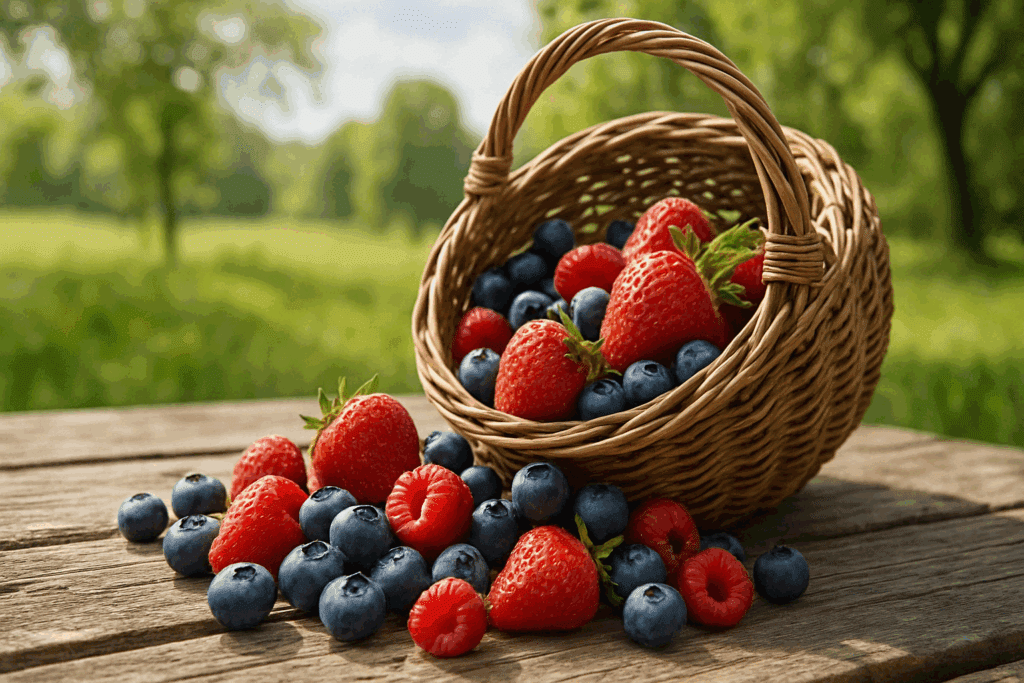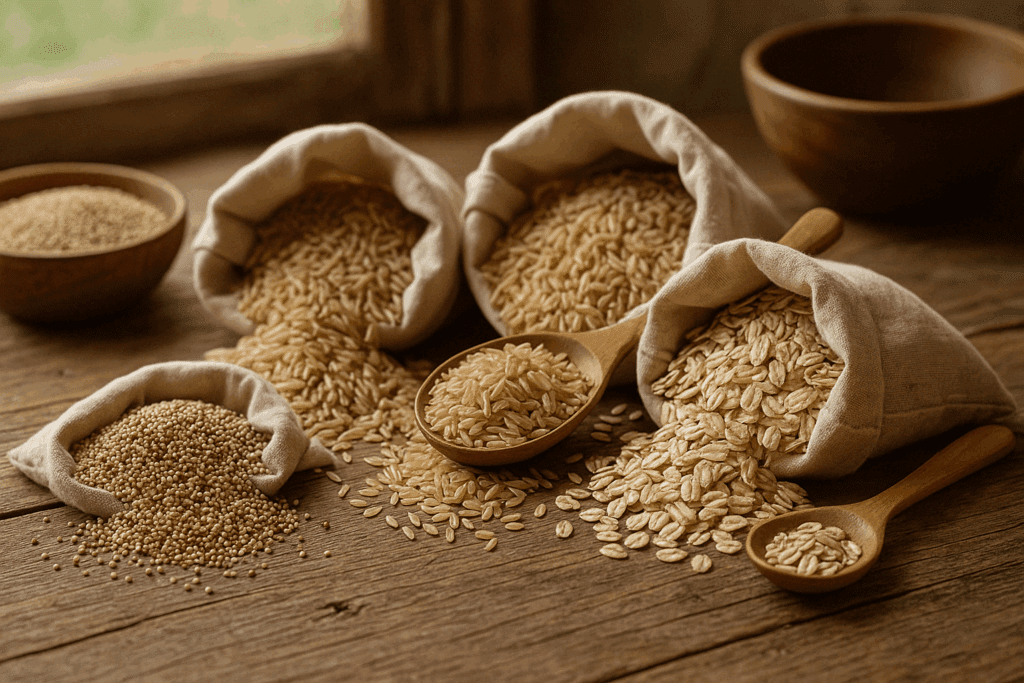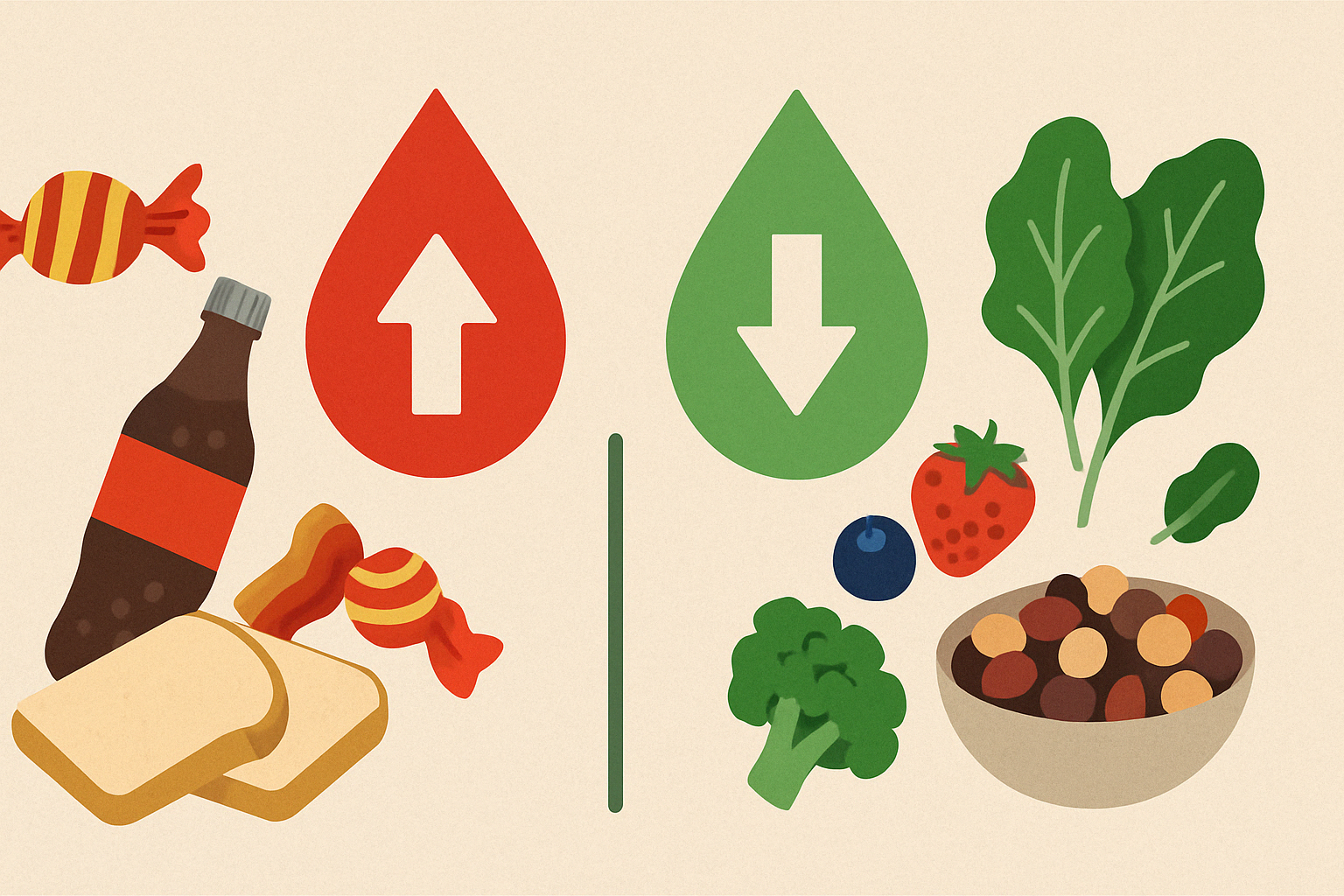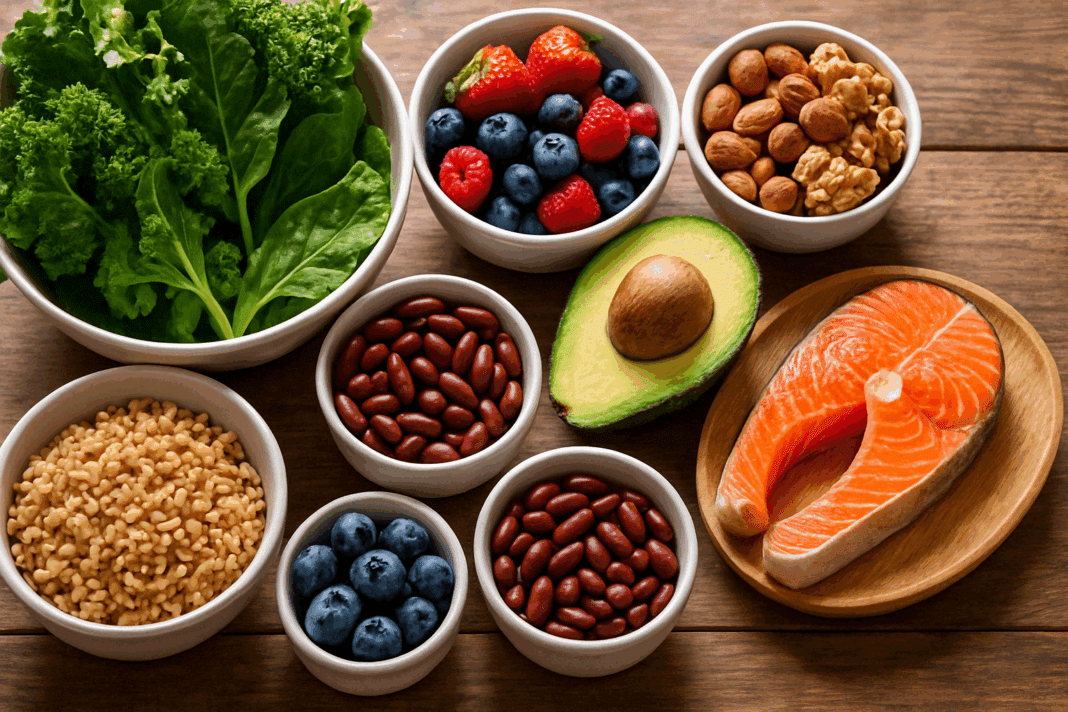Introduction: The Urgent Need for Smart Blood Sugar Management
Maintaining healthy blood sugar levels is not just important for those diagnosed with diabetes; it is essential for everyone aiming for optimal health and longevity. With the rise of prediabetes and type 2 diabetes worldwide, understanding what foods lower blood sugar immediately has become a critical part of public health education. Foods that lower blood sugar offer a natural, effective way to control glucose levels without always relying solely on medication. By making thoughtful dietary choices, individuals can harness the power of nutrition to support their body’s natural regulation mechanisms. This article will explore evidence-based blood sugar lowering foods and how smart eating habits can offer a meaningful strategy for glucose management.
You may also like: 4 Ways to Have a Healthy Diet: Expert Tips Backed by Science for Better Nutrition and Long-Term Wellness
Understanding Blood Sugar Spikes and Why Immediate Action Matters
Blood sugar, or blood glucose, is the body’s main source of energy. However, when glucose levels become too high, either from excessive carbohydrate intake or impaired insulin response, it can lead to both acute and chronic health issues. Spikes in blood sugar levels strain the pancreas and, over time, can damage blood vessels, nerves, and vital organs. Foods that bring down blood sugar quickly are particularly useful after a high-carbohydrate meal or during periods of stress when glucose levels tend to soar. Incorporating foods that will lower blood sugar into daily meals helps maintain balance and reduces the risk of long-term complications.

Key Nutritional Strategies for Lowering Blood Sugar Levels Naturally
An effective diet to lower A1C focuses on foods that are low in simple carbohydrates, rich in fiber, and packed with antioxidants. Soluble fiber slows the absorption of sugar into the bloodstream, thereby preventing sharp spikes. Additionally, certain foods contain bioactive compounds that enhance insulin sensitivity and promote more stable glucose metabolism. Adopting a diet to control A1C involves choosing foods that reduce glucose levels without causing sudden drops, which can be just as dangerous. Balancing proteins, healthy fats, and complex carbohydrates at each meal helps regulate glucose release and maintain energy.
Leafy Greens: Nutrient Powerhouses That Stabilize Blood Sugar
Leafy greens like spinach, kale, and collard greens are celebrated among the most effective vegetables that lower blood sugar. They are incredibly low in carbohydrates and calories, yet packed with fiber, magnesium, and vitamin C—nutrients known to enhance insulin sensitivity. Incorporating these vegetables into meals supports a diet to lower hemoglobin A1C by naturally balancing blood sugar after eating. The antioxidant properties of leafy greens also combat oxidative stress, a contributor to insulin resistance, making them a staple in any prediabetes healthy eating plan. Adding a simple spinach salad or sauteed kale can make an immediate difference in glucose management.

Berries: Sweet Solutions for Glucose Control
While many fruits can cause blood sugar spikes, berries are an exception. Strawberries, blueberries, and raspberries are high in fiber and rich in polyphenols, compounds that help reduce glucose absorption and inflammation. Including berries as part of a diet to reduce A1C provides a satisfying way to enjoy sweetness without destabilizing blood sugar levels. Scientific studies have shown that the anthocyanins in berries can improve insulin sensitivity and lower the risk of developing type 2 diabetes. By choosing berries over processed sweets, individuals can enjoy delicious foods that lower blood sugar while satisfying cravings.
Nuts and Seeds: Small Packages with Big Benefits
Nuts and seeds are among the most effective foods that lower blood glucose due to their ideal balance of healthy fats, fiber, and protein. Almonds, walnuts, chia seeds, and flaxseeds have all been shown to slow carbohydrate digestion and prevent post-meal glucose spikes. Including these in snacks or meals forms an integral part of a diet to bring down A1C naturally. Furthermore, nuts and seeds are rich in magnesium, a mineral essential for insulin function, making them critical for those practicing prediabetes healthy eating. A handful of almonds or a chia seed pudding can offer significant blood sugar benefits without compromising on taste or satisfaction.

Legumes: The Secret Weapon for Blood Sugar Balance
Beans, lentils, and chickpeas are among the top foods that bring down sugar levels efficiently. Their high fiber and protein content slow the release of glucose, preventing sudden spikes. In fact, research has consistently shown that diets high in legumes correlate with improved A1C levels and better overall glucose management. Including legumes regularly supports a low blood sugar diet while providing vital nutrients such as iron, potassium, and folate. Practical ways to incorporate legumes include adding black beans to salads, enjoying a lentil soup, or preparing hummus for a healthy snack.
Whole Grains: Choosing the Right Carbs for Stable Blood Sugar
While refined grains can cause rapid increases in glucose, whole grains like quinoa, brown rice, and oats offer a different story. These foods to lower glucose release their sugars gradually, thanks to their intact fiber and nutrient content. Including whole grains in a balanced way helps to support a diet to control A1C without completely eliminating carbohydrates. The key lies in moderation and pairing grains with proteins and healthy fats to further buffer glucose response. Understanding what foods will lower blood sugar quickly enables smarter choices, turning meals into tools for better health rather than risks.

Fatty Fish: A Protein-Packed Ally Against High Blood Sugar
Salmon, mackerel, sardines, and other fatty fish are renowned for their rich omega-3 fatty acid content, which helps reduce inflammation and support heart health. Less commonly known is their role in lowering blood sugar. High-protein, low-carb foods like fatty fish are excellent for stabilizing glucose levels and fitting seamlessly into a diet to lower A1C. Regular consumption of fatty fish improves metabolic markers and supports insulin efficiency, providing another dimension to smart blood sugar management. Grilling salmon or adding sardines to a salad can be easy ways to harness these benefits.
Avocados: Creamy Goodness That Balances Glucose
Avocados are among the most celebrated foods that balance blood sugar due to their healthy fat profile, fiber content, and low carbohydrate load. Including avocados in meals can slow digestion, reduce glucose absorption, and prevent post-meal spikes, which are vital for those following a diet to bring down A1C. Moreover, the potassium and magnesium in avocados support cardiovascular health, often compromised in individuals with uncontrolled blood sugar levels. Whether used as a spread, in salads, or in smoothies, avocados provide a versatile option for enhancing blood sugar control naturally.
Cinnamon and Other Spices: Flavorful Tools for Glucose Management
Certain spices, notably cinnamon, turmeric, and fenugreek, have shown promising results in lowering blood sugar levels. Cinnamon, in particular, enhances insulin sensitivity and improves glucose metabolism, making it a favorite among foods that lower blood sugar naturally. Adding a sprinkle of cinnamon to oatmeal, smoothies, or coffee can offer subtle but meaningful blood sugar benefits. Turmeric, with its active compound curcumin, fights inflammation and may also improve insulin response. Exploring the culinary use of these spices supports both flavor diversity and smart eating strategies for glucose control.
Hydration and Blood Sugar: Why Water Matters
Water plays a crucial but often overlooked role in blood sugar management. Dehydration can lead to higher blood sugar concentrations and reduce insulin efficiency. Drinking sufficient water daily supports kidney function, helping to flush excess glucose through urine. While foods that reduce blood sugar levels are central, maintaining proper hydration forms an essential backdrop for their effectiveness. Including hydrating foods like cucumbers and watermelon further amplifies these benefits. This highlights how interconnected dietary and lifestyle choices are in achieving better glucose balance.
Meal Timing and Portion Control: Enhancing the Impact of Blood Sugar Lowering Foods
Beyond choosing the right foods, when and how much one eats profoundly affects blood sugar control. Eating smaller, balanced meals throughout the day prevents large glucose swings and helps sustain energy. Combining blood sugar lowering foods with thoughtful meal timing enhances their effectiveness, particularly in those looking to follow a diet to lower hemoglobin A1C. Skipping meals or overeating, on the other hand, can lead to unpredictable glucose responses, undermining even the healthiest food choices. Developing an intuitive relationship with hunger and fullness cues is key to maintaining stable glucose levels.
Addressing Prediabetes with Food: A Proactive Approach
For those diagnosed with prediabetes, adopting prediabetes healthy eating practices is critical to preventing progression to full-blown diabetes. Choosing foods that bring down blood sugar and balancing them strategically throughout the day can dramatically improve insulin sensitivity and restore normal glucose regulation. Foods that will lower blood sugar and foods that reduce glucose levels become primary tools for health preservation in this context. Educational efforts must continue to highlight how early, sustained dietary changes can reverse or halt disease progression, empowering individuals to reclaim their health proactively.
Beyond Food: Holistic Lifestyle Factors That Support Blood Sugar Control
While focusing on what foods lower blood sugar immediately is crucial, other lifestyle factors must be considered for comprehensive glucose management. Regular physical activity, quality sleep, and stress reduction all influence insulin function and blood sugar stability. Integrating these lifestyle habits with a diet to lower A1C creates a synergistic effect, amplifying the benefits of each intervention. For instance, a brisk walk after meals can enhance muscle glucose uptake, further helping to balance blood sugar naturally. Holistic strategies ensure that improvements are sustainable and deeply rooted.
Common Pitfalls to Avoid When Choosing Blood Sugar Friendly Foods
Not all foods marketed as “diabetic-friendly” are genuinely beneficial. Many processed “low-sugar” products contain artificial sweeteners or refined carbohydrates that still impact blood glucose adversely. Reading labels carefully and prioritizing whole, minimally processed foods ensures the integrity of a diet to reduce A1C. Understanding what foods will bring down blood sugar and distinguishing them from misleading options protects individuals from unintended setbacks. Knowledge, vigilance, and a preference for natural foods are the best defenses against nutritional misinformation.

Frequently Asked Questions (FAQ): Managing Blood Sugar Through Smart Nutrition
What foods lower blood sugar immediately during a sudden spike?
Foods rich in soluble fiber and healthy fats can lower blood sugar levels quickly during a suddenspike. Avocados, chia seeds, and almonds are examples of foods that lower blood sugar efficiently without causing a crash later. If you need rapid stabilization, combining a small serving of these with a glass of water can enhance absorption and glucose regulation. Knowing what foods lower blood sugar immediately gives you practical tools to manage those unexpected spikes with confidence. Choosing real, whole foods over processed alternatives provides a safer, more sustainable approach to balancing blood sugar levels.
Are there any blood sugar lowering foods that work better after high-carb meals?
Yes, certain blood sugar lowering foods have been shown to be especially effective after highcarbohydrate meals. Foods like legumes, which are packed with resistant starch, can blunt the post-meal glucose surge when consumed alongside or after carb-heavy dishes. Fermented foods such as kimchi and sauerkraut also help regulate digestion and improve glycemic response. Incorporating foods that bring down blood sugar into meal planning strategies empowers individuals to enjoy diverse meals without extreme glucose fluctuations. The key lies in pairing high-carb foods thoughtfully with ingredients known to slow carbohydrate absorption naturally.
How does a diet to lower A1C differ from general healthy eating?
A diet to lower A1C is more targeted than general healthy eating because it specifically focuses onmaintaining stable glucose levels throughout the day. While general healthy diets prioritize overall nutrient intake, a diet to control A1C emphasizes low glycemic index foods, fiber-rich vegetables, and controlled carbohydrate consumption. Portion control, consistent meal timing, and inclusion of foods that lower glucose become paramount. For individuals seeking to lower their A1C quickly, attention to detail in food selection and meal composition is critical. This approach transforms eating habits into a proactive, medically informed strategy for glucose management.
What vegetables that lower blood sugar are easiest to incorporate daily?
Several vegetables that lower blood sugar can be effortlessly added to daily meals without drasticchanges to routine. Leafy greens like spinach and kale, along with cruciferous vegetables such as broccoli and Brussels sprouts, are prime examples. These foods to reduce glucose levels are versatile and can be included in salads, smoothies, sautéed side dishes, or omelets. Furthermore, vegetables like bell peppers and zucchini offer colorful, low-carb options that contribute to lowering blood sugar without sacrificing flavor. Regularly consuming a variety of these vegetables helps build a low blood sugar diet that feels abundant and satisfying.
Is it possible to reverse early diabetes with nutrition alone?
Emerging research suggests that prediabetes and early-stage type 2 diabetes can often be reversedwith comprehensive lifestyle changes, especially through nutrition. Adopting a plan centered around reverse diabetes foods — such as legumes, nuts, seeds, and non-starchy vegetables — has shown promise in clinical studies. What foods can reverse diabetes include those that improve insulin sensitivity, reduce inflammation, and encourage weight management. When combined with regular exercise and stress management, a food-first strategy can yield remarkable improvements in glucose control and overall health. However, it’s important to collaborate with healthcare providers to tailor an individualized, evidence-based plan.
What are some overlooked foods that balance blood sugar effectively?
While many people focus on popular choices like berries and leafy greens, lesser-known foods thatbalance blood sugar deserve more attention. Artichokes, for example, are rich in fiber and prebiotics that promote gut health and glucose stability. Seaweed, another underappreciated food to lessen blood sugar, provides iodine and unique fibers that support metabolic health. Okra has mucilaginous compounds that slow sugar absorption, making it a valuable addition to a diet to bring down A1C. Including a broader range of these foods helps diversify nutrient intake while supporting optimal blood sugar regulation. Exploration beyond the usual suspects can uncover delicious, powerful allies in managing glucose.
Can meal timing enhance the benefits of foods that lower blood glucose?
Absolutely, strategic meal timing can significantly boost the effectiveness of foods that lower bloodglucose. Eating earlier in the day when insulin sensitivity is naturally higher often results in better glucose control. Spacing meals evenly and avoiding late-night snacking minimizes prolonged elevated glucose levels overnight. Intermittent fasting protocols, when medically appropriate, can further enhance the body’s ability to utilize foods that will lower blood sugar efficiently. Synchronizing meal timing with the body’s circadian rhythm offers a simple but powerful tool to complement a well-planned low blood sugar diet. Thoughtful scheduling of meals transforms timing into an active element of blood sugar management.
What role do fermented foods play in lowering blood sugar?
Fermented foods such as yogurt, kefir, miso, and sauerkraut are increasingly recognized for their rolein lowering blood sugar. These foods populate the gut with beneficial bacteria that influence glucose metabolism and insulin sensitivity. Including fermented options as part of a diet to reduce A1C can indirectly support more stable blood sugar levels through improved gut health. Additionally, some studies suggest that regular consumption of probiotic-rich foods that reduce blood sugar levels may lower systemic inflammation, which is often elevated in metabolic disorders. Integrating these foods offers a holistic way to support glucose control while diversifying the diet.
Are there quick meals that feature foods that bring down sugar levels?
Yes, preparing quick meals using foods that bring down sugar levels is not only possible but highlypractical for busy lifestyles. A simple bowl of Greek yogurt topped with chia seeds and a handful of berries offers fiber, protein, and antioxidants in under five minutes. Stir-fries using vegetables that lower blood sugar like broccoli and spinach combined with lean protein and a dash of turmeric can be prepared swiftly. Smoothies made with avocado, spinach, and unsweetened almond milk deliver rapid, nutrient-dense options ideal for prediabetes healthy eating. Investing a little planning into stocking these ingredients makes fast, glucose-friendly meals an everyday reality.
How can emotional eating impact a diet to control A1C, and what strategies help?
Emotional eating poses a significant challenge to maintaining a diet to control A1C because it oftenleads to the consumption of high-sugar, processed comfort foods. These choices counteract the benefits of foods to lower glucose and can result in erratic blood sugar swings. Mindful eating practices, stress-reduction techniques, and building emotional resilience can all support better adherence to a low blood sugar diet. Substituting emotional eating triggers with healthier rituals, such as preparing a tea ceremony or taking a mindful walk, redirects emotional needs without sacrificing glucose control. Recognizing emotional patterns around food strengthens the foundation for long-term success in lowering blood sugar.

Conclusion: Embracing Smart Eating to Achieve Lasting Blood Sugar Balance
Incorporating foods that lower blood sugar into daily life is a powerful, empowering way to take control of health naturally. Whether addressing immediate spikes or aiming for long-term improvements in A1C, the role of nutrition cannot be overstated. Foods that lower blood glucose offer safe, accessible options for managing a condition that touches millions globally. By embracing a diet to control A1C rooted in whole foods, smart meal composition, and mindful living, individuals can achieve meaningful, sustainable glucose balance. Understanding what to eat to lower glucose levels gives everyone the tools needed to thrive, prevent disease, and live vibrantly. As research continues to evolve, one truth remains clear: smart eating is one of the most effective, immediate, and enduring strategies for achieving optimal blood sugar health.
Was this article helpful? Don’t let it stop with you. Share it right now with someone who needs to see it—whether it’s a friend, a colleague, or your whole network. And if staying ahead on this topic matters to you, subscribe to this publication for the most up-to-date information. You’ll get the latest insights delivered straight to you—no searching, no missing out.
Further Reading:
17 Foods to Lower Your Blood Sugar


